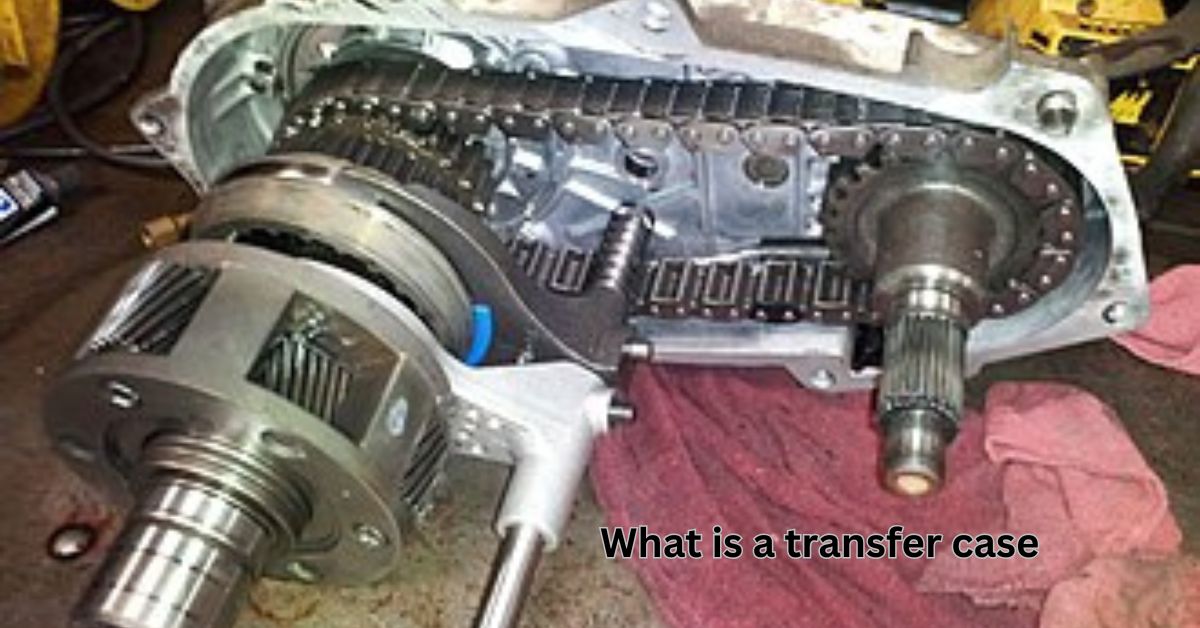TECHNOLOGY
Understanding the Transfer Case: Key to Your Vehicle’s Powertrain

Understanding the Transfer Case: Key to Your Vehicle’s Powertrain
When it comes to understanding a vehicle’s powertrain, most drivers are familiar with components like the engine, transmission, and differential. However, one vital yet often overlooked component that plays a crucial role in the functionality of 4WD (four-wheel drive) and AWD (all-wheel drive) systems is the transfer case. This small but essential part ensures that power is distributed evenly between the front and rear axles, allowing the vehicle to handle rough terrains, slippery conditions, and off-road challenges.
In this article, we will dive deep into what a transfer case is, how it works, its different types, and why it’s crucial to your vehicle’s performance and safety.
What Is a Transfer Case?
A transfer case is a mechanical component found in 4WD and AWD vehicles. Its primary function is to distribute engine power to both the front and rear axles, ensuring that all four wheels can receive power for optimal traction. This is especially important for vehicles that are intended for off-road use, or those designed to operate in challenging weather conditions like snow, rain, or mud.
The transfer case is usually located between the front and rear axles and connects to the transmission. Its role is essential in allowing the vehicle to switch between two-wheel drive (2WD) and four-wheel drive (4WD), as well as to manage the power distribution between the axles.
The Importance of the Transfer Case
Without a functional transfer case, a 4WD or AWD vehicle would not be able to deliver power to all four wheels effectively. This would compromise traction, making the vehicle much harder to control on slippery surfaces, rough terrains, or off-road conditions. The transfer case enables smoother handling, better control, and improved stability when driving in challenging environments.
How Does a Transfer Case Work?
To understand the workings of a transfer case, it’s important to know the basic mechanics behind it. A transfer case is connected to the vehicle’s transmission via a driveshaft. When the engine produces power, the transfer case is responsible for splitting this power between the front and rear axles. It does this through a set of gears, which adjust the torque distribution to ensure proper power delivery.
In a 4WD system, the transfer case can either lock the front and rear axles together, ensuring they rotate at the same speed, or allow for different speeds between the axles when driving on regular roads (such as when cornering). This flexibility is essential for ensuring that the vehicle performs well in various driving conditions.
In AWD vehicles, the transfer case constantly distributes power to both axles without any driver intervention, unlike 4WD systems where the driver typically has control over when the system engages.
Key Functions of the Transfer Case
- Power Distribution: The transfer’s case evenly distributes power to the front and rear axles to ensure all wheels have traction.
- Shifting Between 2WD and 4WD: In 4WD vehicles, the transfer case allows the driver to switch between 2WD and 4WD modes. This is important for driving efficiency and safety in different conditions.
- Torque Multiplication: The transfer case also serves to multiply torque, providing the necessary power for off-road driving. This allows the vehicle to climb steep hills, traverse rugged terrain, and handle heavy loads.
Types of Transfer Cases
Not all transfer’s cases are the same, and understanding the different types can help you choose the right vehicle or make informed decisions about repairs and maintenance.
1. Part-Time Transfer Case
A part-time transfer case is most commonly found in older 4WD systems. It allows the driver to manually switch between 2WD and 4WD modes, depending on road conditions. In part-time systems, only the rear wheels receive power in 2WD mode, and both the front and rear wheels receive power in 4WD mode.
While part-time transfer’s cases are great for off-roading, they can be less efficient on the highway because the front axle is not engaged in 2WD mode. When driving on paved roads, using 4WD can lead to increased wear on the drivetrain components due to the lack of differential movement between the front and rear axles.
2. Full-Time Transfer Case
A full-time transfer case is used in AWD vehicles, where the system is always engaged, and power is distributed to both the front and rear axles at all times. These systems typically feature a center differential that allows the front and rear axles to rotate at different speeds, making them ideal for everyday driving in both wet and dry conditions.
The primary benefit of a full-time system is its ability to provide constant all-wheel traction, improving handling and stability in various road conditions. However, full-time transfer cases are often more complex and may require more maintenance than part-time systems.
3. Shift-On-The-Fly Transfer Case
The shift-on-the-fly transfer’s case combines the best of both worlds. It allows the driver to switch between 2WD and 4WD while the vehicle is in motion. This system uses an electronic or mechanical actuator to engage the front axle when additional traction is needed, making it perfect for transitioning between different terrains without having to stop.
This type of transfer’s case is commonly found in modern 4WD vehicles, providing the convenience of quick engagement without sacrificing performance.
4. Dual-Range Transfer’s Case
A dual-range transfer case features two gear ratios: high-range and low-range. The high-range ratio is used for everyday driving, providing standard traction, while the low-range ratio is used for off-roading and heavy-duty conditions. When the vehicle encounters steep inclines, rough terrain, or requires extra pulling power, the low-range gear ratio provides increased torque and traction, allowing the vehicle to tackle difficult situations with ease.
Signs of a Faulty Transfer Case
Like any other component in your vehicle’s drivetrain, the transfer’s case is prone to wear and tear over time. If not properly maintained, it can malfunction, leading to costly repairs. Below are some common signs that your transfer’s case may be malfunctioning:
- Grinding or Strange Noises: A grinding noise when shifting between 2WD and 4WD modes often indicates an issue with the transfer case gears or bearings.
- Difficulty Engaging 4WD: If you have trouble switching into 4WD or the system fails to engage properly, there may be an issue with the transfer case or its linkage.
- Fluid Leaks: A transfer case that is leaking fluid may have a damaged seal, which could lead to lubrication problems and eventual failure.
- Shuddering or Vibration: If your vehicle shakes or vibrates during acceleration or deceleration, it could be a sign of a faulty transfer case or misalignment in the drivetrain.
- Warning Lights: In modern vehicles, warning lights such as the “check engine” light may illuminate when there is an issue with the transfer case.
Maintaining the Transfer Case
To ensure the longevity and proper functioning of your transfer case, regular maintenance is essential. Here are some maintenance tips:
- Regular Fluid Checks: The transfer case relies on fluid to lubricate its gears and components. Regularly check the fluid level and ensure that it is free from contamination.
- Fluid Changes: Transfer case fluid should be changed at regular intervals, typically every 30,000 to 50,000 miles. This helps to prevent wear and tear on the internal components.
- Listen for Strange Noises: Pay attention to any unusual sounds when shifting gears or driving. If you hear grinding or whining, it’s important to have the transfer case inspected by a professional.
- Proper Usage: Avoid using 4WD on dry, paved roads, as it can cause unnecessary stress on the transfer case and drivetrain components.
Conclusion
The transfer’s case is a vital component in 4WD and AWD vehicles, ensuring that power is properly distributed to both the front and rear axles. It plays a crucial role in providing the traction and control necessary for off-roading and driving in challenging conditions. Whether you have a part-time, full-time, or shift-on-the-fly transfer case, understanding how it works and maintaining it properly can help ensure that your vehicle performs optimally for years to come.
If you notice any signs of transfer case issues, it’s crucial to address them promptly to avoid further damage and costly repairs. By staying on top of maintenance and being aware of the signs of trouble, you can keep your vehicle’s powertrain running smoothly and safely.
TECHNOLOGY
The Rise of the Quartist in the Age of AI and Web3

Quartist definition: A quartist is a creative innovator who merges quantum concepts, technological thinking, and artistic vision to craft experiences that challenge the boundaries of perception.
This coined term symbolizes a new identity for creators who aren’t confined by traditional art mediums. Instead of brush and canvas alone, the quartist’s tools include algorithms, data sets, blockchain networks, and interactive digital environments.
In digital culture, what is a quartist is best described as someone embodying multi-dimensional creativity — fusing logic, imagination, and innovation into one coherent form. Whether in music, digital art, architecture, or Web3 brand development, quartists use technology not as a barrier but as a brushstroke of infinite potential.
Quartist Meaning in Digital Culture
In today’s interconnected world, creativity no longer lives inside galleries or studios. It thrives within algorithms, AI art generators, and decentralized online communities. Here, the quartist meaning in digital culture becomes clear — it’s the celebration of creative diversity shaped by computation and consciousness.
A quartist might create NFT art that reacts in real-time to audience data, design immersive VR experiences based on quantum simulations, or build brands that embody technological storytelling. The quartist’s strength lies in fluid identity — adapting creativity to both digital and physical dimensions.
One digital designer recently tweeted:
“We’re not just artists anymore. We’re quartists — painting in qubits, sculpting in data, composing in code.”
That sentiment perfectly captures how the coined term quartist reflects a cultural shift. Creativity has entered a quantum phase, where imagination, data, and energy exist in a perpetual state of possibility.
The Evolution of the Term “Quartist”
The coin a term quartist movement began as an organic evolution in digital spaces. It reflects humanity’s desire to define a new class of creators who transcend old labels. The word itself blends quantum and artist, representing the union of art’s emotional resonance with science’s structured precision.
Over the past few years, similar coined identities have gained traction — think technologist-artist, bio-designer, or neuro-creator. Yet quartist stands apart for its philosophical depth. It implies not only mastery of digital tools but also awareness of interconnected realities — where creativity reflects the dynamic, non-linear fabric of existence itself.
Creative Branding and the Quartist Identity
From an entrepreneurial viewpoint, creative branding quartist identity offers something invaluable — originality. In an era saturated with generic brand names, the quartist label is a goldmine for differentiation. It conveys intellect, imagination, and futurism all at once.
For freelancers, startups, or digital agencies, adopting “quartist” as part of their branding suggests a blend of artistry and technical sophistication. It resonates with audiences seeking authentic innovation rather than repetitive marketing clichés.
A brand adopting this identity could easily position itself as a pioneer in tech-driven creativity — connecting with industries from AI and VR to blockchain and design.
Quartist Technology Art Fusion: The Future of Creative Expression
The quartist technology art fusion represents an era where creative professionals don’t just use technology — they speak its language.
Imagine digital artists designing with quantum algorithms, musicians composing through neural network harmonics, or architects visualizing structures using data-driven generative systems. Each of these is an example of quartism in motion.
This movement aligns perfectly with the concept of posthuman creativity — a recognition that artistic genius isn’t confined to human skill but amplified through collaboration with intelligent systems.
In 2025, quartists are the vanguards of a hybrid reality. They understand that true creativity lies not in resisting technology, but in embracing its rhythm — choreographing data and emotion into unified expression.
Brandable Coined Word “Quartist”
From a linguistic and marketing perspective, quartist is a highly brandable coined word. Its phonetic structure is clean, concise, and internationally understandable. It evokes curiosity and sophistication while remaining approachable.
Marketers and naming experts often seek zero-competition keywords — words with unique digital footprints that instantly dominate search results. Quartist fits this profile perfectly. It’s SEO-ready, culturally resonant, and emotionally compelling.
Furthermore, as digital entrepreneurs and Web3 creators look for unique brand name ideas, quartist could inspire names for creative collectives, design studios, NFT projects, or even metaverse platforms.
Innovation Naming Strategy: Why Quartist Works
An innovation naming strategy quartist approach involves creating terms that reflect futuristic relevance and emotional appeal. Quartist accomplishes both by merging conceptual novelty (quantum + artist) with universal resonance (creativity and self-expression).
Successful coined words share several traits:
Memorability – Short and easy to recall.
Cultural adaptability – Works across languages and industries.
Emotional trigger – Suggests passion, depth, and artistry.
SEO uniqueness – Faces no keyword competition.
“Quartist” meets all four. It captures innovation while maintaining human warmth — a balance that many tech brands struggle to achieve.
Quartist in Art and Science
In the broader intellectual context, quartist in art and science reflects an ongoing synthesis of knowledge and creativity. The modern creator doesn’t draw lines between scientific discovery and aesthetic wonder.
From quantum physics to generative AI, the quartist mindset sees beauty in complexity. Scientists visualize equations as art, while artists use scientific models to explore new aesthetics. This interdisciplinary approach fuels innovation in fields like bio-design, data visualization, and experimental architecture.
For example, an AI researcher might design visualizations of entanglement patterns, transforming mathematical data into mesmerizing art. That’s the essence of quartism — seeing the poetry in the algorithm.
Coined Term Digital Culture Quartist
Within digital culture, the quartist identity reflects a growing philosophical movement — one that values curiosity, fluidity, and digital consciousness.
Coined terms like “quartist” evolve naturally from online subcultures where creators experiment with new linguistic identities. On platforms like Behance, Reddit, or Dribbble, designers describe themselves as quartists to signal versatility — mastery of art and tech combined.
In digital anthropology, this linguistic evolution represents how the internet continuously reinvents human identity. As AI tools democratize creation, new words arise to define previously unimaginable creative roles. Quartist is one of them.
Unique Brand Name Ideas: Quartist as a Concept
When brainstorming unique brand name ideas quartist, several creative directions emerge:
Quartist Studios – a hybrid art-tech production house.
The Quartist Collective – a network of multidisciplinary creators.
Quartist Lab – a think tank for innovation and design.
Project Quartist – a metaverse-based collaborative platform.
Each of these names emphasizes the power of combining imagination with intellect. They communicate sophistication and modernity — perfect for 2025’s innovation economy.
Quartist vs Artist vs Quantum Artist
The quartist vs artist vs quantum artist comparison helps clarify the identity’s distinctiveness.
| Identity | Core Focus | Tools | Mindset | Scope |
|---|---|---|---|---|
| Artist | Expression through emotion and aesthetics | Traditional or digital mediums | Creative and intuitive | Cultural and personal impact |
| Quantum Artist | Integrating quantum theory with art | Quantum data, simulation, algorithms | Experimental and scientific | Conceptual and theoretical art |
| Quartist | Synthesizing quantum, digital, and emotional layers | AI, blockchain, data art, mixed reality | Holistic and interdisciplinary | Technological, cultural, and brand innovation |
A quartist goes beyond being a digital or quantum artist — they represent the convergence point of creativity and computation.
The Role of Quartists in the Web3 Era
As decentralized ecosystems grow, the quartist mindset is becoming central to innovation. In Web3, creativity is tokenized, ownership is shared, and collaboration happens across digital borders.
A naming for Web3 startup quartist approach might involve using quartist principles — combining emotional storytelling with technological depth. Startups adopting this naming strategy could appeal to investors and audiences looking for forward-thinking, culture-driven innovation.
In 2025, Web3 startups thrive on authenticity. A name like Quartist carries symbolic power — it implies originality, intelligence, and human-AI harmony.
The Philosophy Behind Quartism
At a deeper level, quartism isn’t just a style — it’s a philosophy of creation. It acknowledges that art and science aren’t opposites but reflections of the same universal logic.
To think like a quartist is to see patterns in chaos, to find rhythm in randomness, and to celebrate imperfection as part of innovation.
In a quantum universe, every possibility exists simultaneously. Similarly, the quartist embraces multiplicity — designing, coding, painting, and imagining in parallel dimensions.
Real-World Applications of Quartist Thinking
The quartist identity already manifests across industries:
AI art collectives creating generative exhibitions.
Quantum visualization labs turning data into immersive art.
Blockchain-based design firms redefining ownership and creativity.
Hybrid musicians blending algorithmic composition with human emotion.
These innovators embody the quartist ethos — merging computation with culture to inspire change.
FAQ’s
What does quartist’s mean?
Quartist refers to a new-age creator or innovator who merges technology, quantum thinking, and artistic expression to produce transformative work.
How is a quartist’s different from a traditional artist?
Unlike traditional artists, quartists integrate digital systems, algorithms, and data as core creative tools, expanding art beyond material boundaries.
Why is quartist’s considered a coined term in digital culture?
Because it’s a neologism created to represent the evolving identity of tech-enabled creators who exist at the intersection of art and innovation.
How can a startup or creator use quartist’s for branding?
Businesses or individuals can adopt quartist as a brand identity to convey futurism, originality, and tech-art synergy — appealing to modern, innovation-driven audiences.
Final Thoughts
The rise of quartist signals more than a trend — it represents a paradigm shift in how humanity defines creativity. As we move further into the quantum-AI era, the quartist becomes a symbol of adaptation, curiosity, and courage.
TECHNOLOGY
How Eporer Is Transforming Online Communities

At its core, the eporer platform represents a digital ecosystem that merges identity, creativity, and technology into one unified space. It’s built around a principle of ownership and transparency, allowing users to maintain full control over their creative work while engaging in a community that rewards authenticity.
Unlike conventional social or publishing platforms, eporer is designed to adapt — it evolves with the user. Through intelligent design, it encourages participation and collaboration, allowing artists, writers, and thinkers to co-create across borders.
The eporer platform enables creators to publish, monetize, and manage digital assets seamlessly, emphasizing both privacy and innovation. Its intuitive interface bridges technology and creativity, making it appealing to those who want flexibility without complexity.
The Eporer Community: Building Connection Through Creativity
The eporer community thrives on shared passion, authenticity, and forward-thinking creativity. Members aren’t just users — they’re participants in a movement that values originality and voice.
This community operates on the belief that collaboration drives growth. Whether it’s designers collaborating on digital art projects or developers co-creating tools within the eporer framework, everyone contributes to the larger ecosystem.
One creator in the community once remarked, “Eporer feels like a space that finally respects creators — not just their work, but their intent behind it.” That sentiment captures the platform’s purpose: to restore balance between creativity and control in the digital era.
The Concept and Philosophy Behind Eporer
The eporer concept goes far beyond a product or platform — it’s a philosophical approach to digital presence. It challenges centralized systems and questions the traditional boundaries of ownership in online environments.
At its heart lies the eporer philosophy: your identity and creativity should never be separated. In a time when algorithms often dictate visibility and value, eporer aims to return agency to the creator. It promotes transparency, collaboration, and identity-driven innovation.
This philosophy resonates deeply with modern users who are tired of fleeting trends and profit-driven platforms. Eporer reimagines what online existence can mean — not just sharing content but shaping culture.
Eporer Identity: Redefining Digital Presence
The eporer identity system is a key innovation. Instead of fragmenting user presence across multiple accounts and platforms, eporer builds a unified identity that connects all your creative expressions.
This integrated approach means you can publish, share, and interact across digital spaces without losing ownership or visibility. The system maintains your creative fingerprint — your unique aesthetic, tone, and purpose — across every engagement.
Through blockchain-like verification and advanced metadata frameworks, eporer identity ensures content traceability, giving creators full transparency about where their work appears and how it’s used.
Eporer for Creators: Empowerment Through Design
For creators, eporer for creators represents freedom. It eliminates unnecessary intermediaries, enabling direct connection with audiences. Whether you’re a musician, writer, designer, or filmmaker, eporer simplifies the process of sharing ideas while protecting your intellectual property.
Its design encourages experimentation — an essential part of creativity. The platform’s structure allows for multiple types of media: visual art, text, code, music, or mixed formats. This inclusivity drives diversity and innovation across disciplines.
Moreover, eporer adoption is rapidly growing among professionals who value hybrid creation models. For example, digital artists are using it to mint interactive art pieces while educators are using it to publish open learning materials.
Key Eporer Features That Define Its Uniqueness
The eporer features stand out because they align with both creator needs and ethical innovation. Here are some notable highlights:
Unified Creative Workspace: Combines publishing, collaboration, and feedback tools into one dashboard.
Identity Integration: Protects authorship and attribution through a transparent identity framework.
Decentralized Structure: Reduces reliance on third-party hosting, promoting independence and resilience.
Customizable Profiles: Each user can build a branded digital portfolio reflecting their creative journey.
Community Collaboration: Built-in chat and co-creation tools help users network across projects.
Monetization Options: From tips to premium subscriptions, creators can monetize without losing authenticity.
Data Transparency: Users maintain full access and control over their content analytics.
These eporer features make it both a creative hub and a digital identity platform — something few competitors can match.
The Eporer Movement and Its Growing Influence
The eporer movement represents a growing cultural shift toward authenticity and creator empowerment. It’s not just about using a new platform — it’s about adopting a mindset that values openness, ownership, and creativity without compromise.
This movement aligns with modern trends such as decentralization, ethical AI, and sustainable digital design. It challenges legacy platforms that profit from user data without equitable exchange.
As part of the eporer trend, individuals are embracing new ways to define value online — not just in likes or followers, but in meaningful contribution and community participation.
Comparing Platforms: Eporer vs Other Systems
When comparing eporer vs other platforms, one thing stands out — balance.
Where social media networks focus on engagement metrics and content monetization, eporer focuses on integrity and innovation. It doesn’t commodify creativity but elevates it.
For example, platforms like Medium or Substack emphasize distribution, but eporer integrates creation, sharing, and identity into one experience. Similarly, while NFT platforms focus on digital ownership, eporer goes beyond assets — it connects identity with creativity itself.
This holistic model positions it as a next-generation digital ecosystem — one that bridges technology and philosophy seamlessly.
The Role of Design and Culture in Eporer
The eporer design philosophy celebrates minimalism and adaptability. Every interface element serves a purpose: to enhance creative flow and human connection. The design promotes emotional resonance, making interaction feel natural rather than mechanical.
Simultaneously, eporer culture is emerging as a digital renaissance — where collaboration replaces competition. This shift encourages interdisciplinary dialogue, blending artists with engineers, philosophers with developers.
The eporer culture is not about uniformity but shared growth. It rewards curiosity, innovation, and ethical creation — values often lost in traditional digital ecosystems.
Applications of Eporer Across Digital Ecosystems
The eporer application model extends across industries. It’s not limited to art or tech but touches education, entrepreneurship, and personal branding.
- In Education: Teachers use eporer to share course materials collaboratively.
- In Business: Startups apply eporer’s structure to design transparent ecosystems for product development.
- In Personal Branding: Freelancers use eporer to unify portfolios and control online reputation.
- In Art: Digital creators use it to produce interactive exhibitions with identity verification.
Such versatility makes the eporer digital ecosystem a foundation for cross-industry innovation.
Eporer Branding and Its Impact
Eporer branding emphasizes authenticity and creative trust. It communicates a commitment to empowering individuals rather than exploiting audiences.
The brand’s aesthetic — clean, symbolic, and progressive — mirrors its core values: identity, transparency, and evolution. As it expands globally, eporer branding continues to inspire creators who see technology as a medium for meaning rather than noise.
Eporer Adoption: Challenges and Opportunities
Like all innovations, eporer adoption comes with challenges. Its decentralized framework requires users to adjust to new models of ownership and collaboration. But early adopters see it as a step toward genuine digital empowerment.
The opportunity lies in education — helping creators understand that technology can protect, not replace, their identity.
The Future of Eporer: A New Creative Renaissance
In the coming years, eporer is poised to become a cornerstone of digital transformation. Its blend of technology, culture, and identity redefines how creativity functions in interconnected worlds.
As AI, blockchain, and human expression converge, eporer philosophy will remain relevant — serving as a reminder that technology should amplify human potential, not diminish it.
FAQ’s
What is Eporer and how does it work?
Eporer is a digital platform and ecosystem designed to integrate identity, creativity, and community. It provides creators full control over their content while promoting collaboration and transparency.
What makes Eporer different from traditional platforms?
Unlike centralized networks, eporer prioritizes ownership and creator autonomy. It combines content creation, sharing, and monetization within a single ethical framework.
Who can use Eporer?
Anyone can. It’s ideal for creators, educators, designers, and brands looking to build authentic digital presences.
How does Eporer benefit creators?
Eporer enables creators to maintain identity integrity, reach audiences directly, and monetize content without losing control.
Final Thoughts
Eporer isn’t just a trend — it’s a digital evolution. By merging creativity, identity, and technology, it stands as a model for how the internet can evolve toward fairness and innovation.
TECHNOLOGY
How Insetprag Transforms Prague Pest Control

Pests have always been a problem, but in recent years, rising global temperatures, increased travel, and urban density have made insect infestations more common and harder to control. Traditional chemical sprays often bring more harm than good, leading people to look for environmentally safe repellents that won’t damage ecosystems.Insetprag represents this shift. It’s not just about exterminating pests; it’s about balancing prevention, removal, and sustainable solutions.
Imagine living in Prague during summer: mosquitoes thrive near the Vltava River, ants sneak into cafes, and bed bugs occasionally spread through hotels. For locals and tourists alike, reliable Prague pest control services are a necessity. Insetprag aims to provide comprehensive, eco-conscious, and technologically advanced options.
The Evolution of Insect Control Solutions
From Chemicals to Eco Pest Management
In the past, chemical pesticides dominated the pest control industry. While they were effective, they left behind toxic residues that harmed soil, water, and non-target species. Today, eco pest management is leading the way.
Biological controls: Using natural predators like ladybugs to combat aphids.
Essential oil sprays: Safer, plant-based alternatives for household use.
Integrated Pest Management (IPM): Combining prevention, monitoring, and targeted treatment.
The benefit? Long-term effectiveness without the collateral damage.
Insect Repellent Devices That Work Smarter
One of the biggest shifts in 2025 has been the rise of insect repellent devices powered by AI and IoT. These gadgets not only repel insects but also collect data on pest activity.
Some of the most popular innovations include:
Ultrasonic repellents that use sound waves to deter pests.
Smart bug zappers with energy-efficient LED lights.
Wearable repellents, perfect for outdoor activities.
These devices reduce the need for harmful sprays while providing continuous household insect protection.
Prague Pest Control Services: Local Expertise Meets Innovation
If you live in Prague, you’ve likely noticed an increase in professional pest control services offering modernized packages. Traditional exterminators now combine insect removal services with smart monitoring systems.
For instance:
A family in Prague 7 installed a smart pest control system that automatically detects bed bugs in furniture.
Restaurants in Old Town are using bug trap technology that integrates with mobile apps to alert managers about cockroach activity before it becomes a full infestation.
This integration of traditional expertise with modern technology makes Prague a leader in urban pest management.
The Science Behind Insect Prevention Methods
Prevention has always been better than cure. But in 2025, insect prevention methods have become more advanced, combining design, materials, and data-driven insights.
Smart window screens that release micro-doses of repellents.
Soil-based solutions that discourage ants from nesting near homes.
Moisture control systems that reduce environments where mosquitoes breed.
By adopting these methods, homeowners can drastically reduce their dependence on chemical sprays.
Bug Trap Technology: A Closer Look
Bug trap technology has gone beyond sticky boards and flypaper. In 2025, traps are smarter, more targeted, and environmentally conscious.
Pheromone traps attract specific insects like moths or beetles.
AI-powered traps analyze captured insects to provide prevention tips.
Solar-powered traps offer a sustainable solution for outdoor use.
One user recently tweeted: “Never thought I’d geek out over a bug trap, but my smart insect catcher just pinged me with data about mosquito activity in my backyard. This is the future!”
Smart Pest Control Systems: Automation at Its Best
Smart homes are no longer just about lighting and thermostats—they now include smart pest control systems. These systems integrate with home assistants like Alexa or Google Home to provide updates on insect activity.
Automatic scheduling of repellents.
Real-time alerts about unusual pest behavior.
AI-driven recommendations for prevention.
This level of automation brings peace of mind, especially for households with children and pets.
Household Insect Protection in Everyday Life
Let’s talk practicality. What does household insect protection actually look like for a typical family?
Kitchen hygiene: Smart bins that seal automatically to prevent flies.
Bedroom defense: Anti-mosquito smart screens and essential oil diffusers.
Garden care: Eco-friendly sprays that don’t harm pollinators.
With these steps, homes remain comfortable without sacrificing safety or sustainability.
The Rise of Insect Removal Services
While prevention is ideal, infestations still happen. That’s where professional insect removal services step in. In 2025, these services are more customer-friendly, data-driven, and eco-conscious.
On-demand apps allow you to book pest control within hours.
Services guarantee environmentally safe repellents instead of harsh chemicals.
Real-time tracking shows when and where technicians treated your property.
This makes pest control less intimidating and far more transparent.
Balancing Innovation with Environmentally Safe Repellents
Perhaps the biggest challenge in pest management has always been safety. Harsh pesticides can kill pests, but they often harm beneficial insects like bees. That’s why environmentally safe repellents are at the heart of modern solutions.
Examples include:
Neem oil sprays.
Citronella candles.
Non-toxic gels for cockroaches.
These options strike the balance between effectiveness and ecological responsibility.
Real-Life Example: Insetprag in Action
In insetprag, a café owner faced recurring issues with fruit flies near their bar. Instead of relying on chemical sprays, they installed a smart bug trap technology system combined with eco pest management techniques like regular waste monitoring and herbal repellents. Within two weeks, the fly population dropped by 80%, without any disruption to customers.
The owner said: “It was a relief to find something that worked without risking my staff’s health or the taste of our cocktails.”
Pros and Cons of Modern Pest Control
Pros
Eco-friendly and safe for children/pets.
Data-driven and preventive.
More affordable in the long run.
Cons
Higher upfront costs for smart devices.
Some eco repellents need frequent reapplication.
Dependence on apps may feel overwhelming for older users.
FAQ’s
How effective are eco pest management solutions compared to chemical sprays?
Eco pest management is just as effective in the long term because it focuses on prevention, monitoring, and targeted solutions. While chemical sprays may give quick results, eco methods prevent re-infestation and avoid harmful side effects.
Can smart pest control systems replace traditional insect removal services?
Not entirely. Smart systems are excellent for prevention and monitoring, but when infestations get severe, professional insect removal services are still necessary.
Are insect repellent devices safe for kids and pets?
Yes, most modern insect repellent devices are designed with safety in mind, using ultrasonic waves or natural repellents instead of toxic chemicals.
What’s the best insetprag prevention method for city apartments?
For urban living, Prague pest control services recommend sealing entry points, installing smart screens, and using eco-friendly indoor repellents.
Conclusion
Insetprag isn’t just a product—it’s a movement toward smarter, safer, and more sustainable pest management. With innovations in bug trap technology, smart pest control systems, and environmentally safe repellents, we’re entering a new era of household and commercial protection.
-

 GENERAL9 months ago
GENERAL9 months agoClassroom6x: Revolutionizing the Future of Learning
-

 ENTERTAINMENT9 months ago
ENTERTAINMENT9 months agoUnveiling the Mystery of Kashito_Toto: A Digital Frontier
-

 TECHNOLOGY9 months ago
TECHNOLOGY9 months agoUnlocking the Power of SSIS 816: A New Era in Data Integration
-

 TECHNOLOGY8 months ago
TECHNOLOGY8 months agoUnlocking the Mystery of Vy6ys: A Hidden Gem
-

 GENERAL8 months ago
GENERAL8 months agoUnraveling Time: What Hour Was It 8 Hours Ago?
-

 GENERAL8 months ago
GENERAL8 months agoQuid Pro Quo Harassment: What It Is and Why It Matters
-

 BUSNIESS8 months ago
BUSNIESS8 months agoWhat Does ‘In Transit’ Mean? Understanding Shipment Status
-

 GENERAL8 months ago
GENERAL8 months agoWhat does reshmina like
